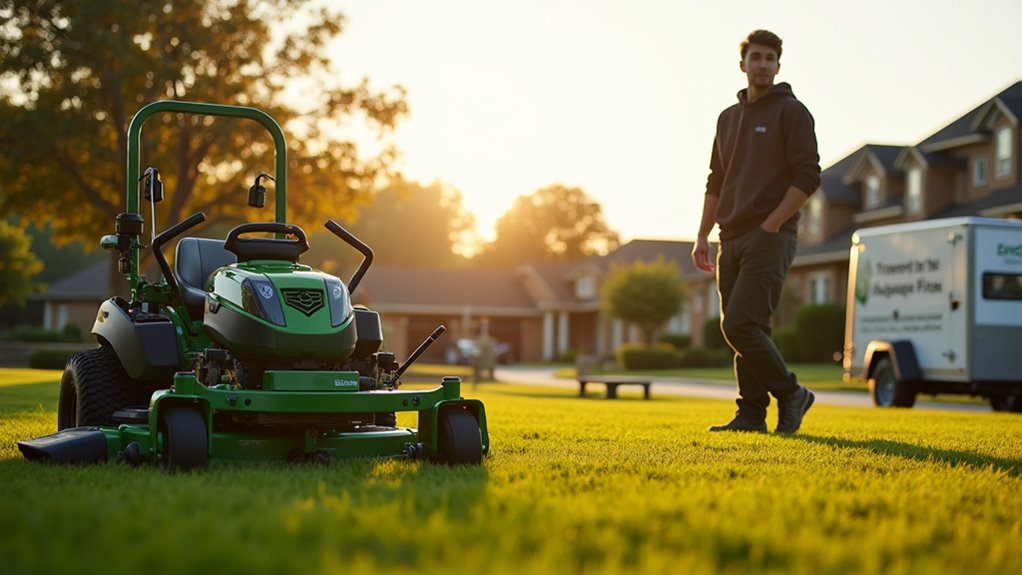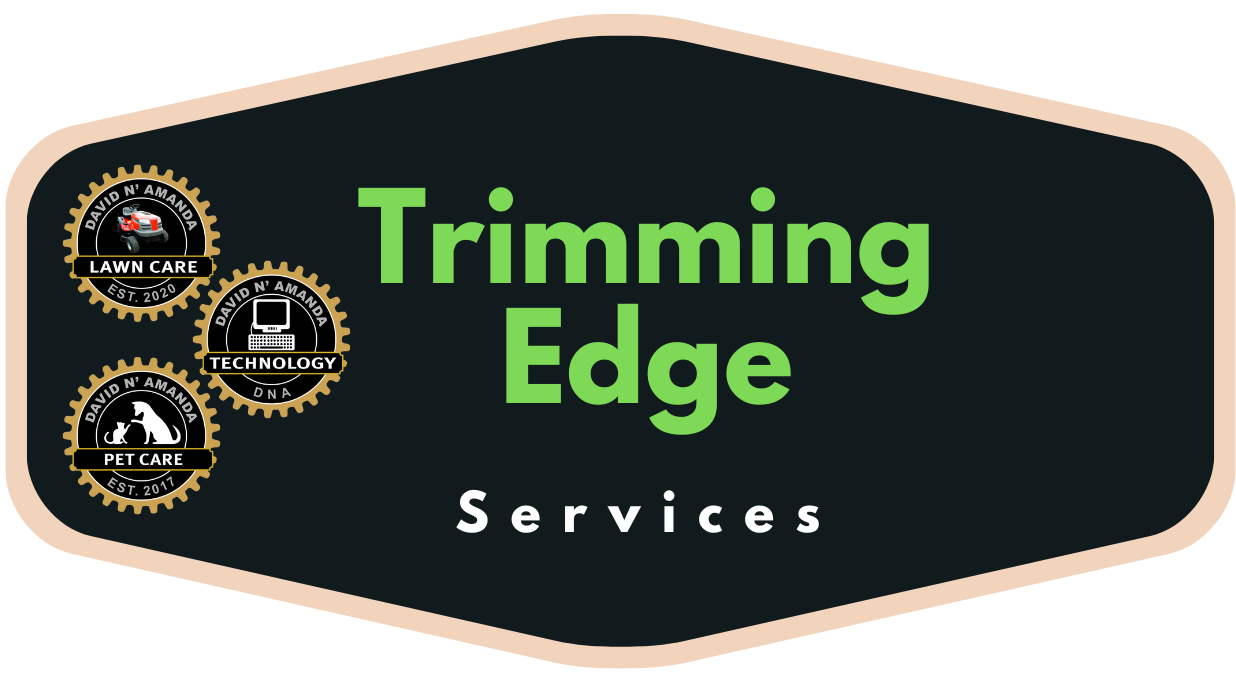To start your lawn care business in 2025, you’ll need to secure proper licensing, insurance, and permits, with general liability coverage of at least $1 million. Begin with essential equipment ($7,000-$15,000 investment) while developing service packages that include both traditional and eco-friendly options. Create a strong digital presence through an SEO-optimized website and social media marketing. Implement automated solutions and smart irrigation technology to stay competitive. Our extensive guide examines every vital step to launch your successful venture.
Market Analysis and Business Planning

Before launching your lawn care business in 2025, conducting thorough market research and creating a detailed business plan will set the foundation for success. You’ll need to analyze current market trends in your service area, including population growth, housing developments, and emerging eco-friendly preferences. Study local competitors’ service offerings, pricing structures, and market positioning to identify gaps you can fill.
Your business plan should outline specific financial projections, startup costs, and operational strategies. Include detailed competitor analysis focusing on their strengths and weaknesses. Define your target customer segments, whether they’re residential homeowners, commercial properties, or both. Don’t forget to factor in technological advancements like automated mowing systems and smart irrigation controls that are reshaping the industry’s environment in 2025.
Legal Requirements and Licensing
To establish your lawn care business legally in 2025, you’ll need to complete critical registration steps with your state’s Secretary of State office and obtain an Employer Identification Number (EIN) from the IRS. You’ll require extensive general liability insurance coverage, along with workers’ compensation if you plan to hire employees, while equipment insurance protects your valuable machinery investments. Local municipalities mandate specific permits for commercial lawn maintenance operations, so check with your city’s business development office to secure the necessary paperwork and stay compliant with zoning regulations.
Business Registration Steps
Registering your lawn care business requires five essential legal steps to operate legitimately in 2025. Begin by selecting your business name and registering it with your state’s Secretary of State office. Then, determine your entity selection, whether it’s a sole proprietorship, LLC, or corporation, as this impacts your tax obligations and liability protection.
- File for your Employer Identification Number (EIN) through the IRS website, which you’ll need for tax purposes and hiring employees
- Register for state and local business licenses, including specific permits required for pesticide application and equipment operation
- Set up a separate business bank account and obtain necessary insurance coverage, including general liability and workers’ compensation if you plan to hire staff
Each jurisdiction has unique requirements, so consult with a local business attorney to guarantee full compliance.
Insurance Coverage Requirements
Building on your business registration, proper insurance coverage forms the backbone of a protected lawn care operation in 2025. You’ll need extensive liability coverage to shield your business from potential claims and lawsuits. Start with a minimum $1 million general liability policy to protect against property damage and personal injury claims.
| Insurance Type | Coverage Amount | Annual Cost |
|---|---|---|
| General Liability | $1M-$2M | $500-$1,200 |
| Commercial Auto | $500K | $1,000-$2,500 |
| Equipment | $50K-$100K | $300-$800 |
| Workers’ Comp | State Mandated | $2,000-$4,000 |
| Umbrella Policy | $1M+ | $700-$1,500 |
Don’t skimp on coverage one major incident could devastate an underinsured operation. Consider bundling policies with a single provider to reduce premiums and streamline claims processing.
Local Permit Applications
Four essential permits form the foundation of a legitimate lawn care business in 2025: a general business license, pesticide applicator certification, contractor’s license, and local operating permit. You’ll need to navigate local regulations and zoning laws while following specific compliance guidelines for each permit type.
- Submit your application process through your city’s business portal, providing proof of insurance, tax ID, and equipment inspection requirements. Fee structures vary by municipality, but expect to budget $500-1,500 for initial permits.
- Schedule mandatory site inspections and equipment evaluations with local authorities. They’ll verify your compliance with environmental standards and safety protocols.
- Track renewal procedures carefully – most permits require annual updates. Set calendar reminders 60 days before expiration to maintain continuous operational status and avoid late penalties.
Essential Equipment and Startup Costs
Starting a lawn care business in 2025 requires a smart investment in essential equipment, with typical startup costs ranging from $7,000 to $15,000 for professional-grade gear. You’ll need reliable lawn mowers as your primary tools, including both a riding mower for larger properties and a walk-behind model for smaller yards. Quality trimming tools are essential for detailed work and edge maintenance.
| Equipment Type | Cost Range |
|---|---|
| Commercial Mowers | $3,000-6,000 |
| Handheld Tools | $1,500-2,500 |
| Transport Vehicle | $2,500-6,500 |
Beyond equipment, factor in costs for insurance, marketing materials, and a basic website. Consider starting with essential items and expanding your inventory as your client base grows. Smart equipment choices now will reduce replacement costs and downtime later.
Setting Your Service Rates

To set competitive rates for your lawn care services in 2025, you’ll need to calculate your total operating expenses, including equipment maintenance, fuel costs, labor, and insurance. Research your local market thoroughly by examining competitors’ pricing structures and analyzing the specific demographics of your service area. You can then develop tiered service packages that combine basic mowing with premium offerings like fertilization and outdoor design, ensuring profitability while providing value to your clients.
Calculate Your Operating Costs
Understanding your operating costs is crucial before setting competitive lawn care rates that guarantee profitability. To develop accurate operating expense estimation, you’ll need to track both fixed and variable costs systematically. Cost management strategies should focus on identifying and monitoring all business expenses.
Your essential operating costs include:
- Equipment expenses: Mowers, trimmers, blowers, fuel, maintenance, repairs, and depreciation calculations
- Labor costs: Your time (owner salary), employee wages, payroll taxes, workers’ compensation, and training expenses
- Business overhead: Insurance, licenses, marketing, vehicle expenses, office supplies, and professional services
Factor these costs into your hourly rate calculations to guarantee each job covers expenses while generating sufficient profit. Keep detailed records and review costs quarterly to adjust your pricing strategy as market conditions change.
Research Local Market Prices
Once you’ve calculated your operating expenses, proper market research becomes your next strategic step for setting competitive rates. Start by analyzing 5-7 established lawn care companies in your area, noting their service packages and pricing structures. You’ll find most competitors list basic mowing rates between $35-75 per hour, depending on your region.
Develop your local pricing strategies by considering factors beyond just matching competitor rates. Account for lot sizes, terrain complexity, and seasonal demand in your market. Your competitor analysis should examine their equipment quality, crew size, and service guarantees. Don’t forget to research pricing for add-on services like edging, leaf removal, and fertilization. Most successful companies offer tiered pricing packages that bundle multiple services, allowing for better profit margins while providing value to customers.
Structure Service Package Pricing
Three fundamental pricing models serve as the foundation for structuring your lawn care service packages. When developing your pricing strategies, you’ll need to balance competitive market rates with profitable margins while offering clear value to your customers.
- Basic Package: Offer essential mowing, edging, and cleanup services at an entry-level price point to attract new clients and establish recurring revenue
- Premium Package: Include advanced services like fertilization, weed control, and seasonal treatments at a higher price tier for thorough lawn maintenance
- Custom Package: Create flexible service package options that allow clients to select specific services based on their needs and budget
Choose your pricing model carefully, as it’ll impact your business’s scalability and profitability. Consider implementing seasonal discounts and loyalty programs to improve customer retention while maintaining competitive rates.
Building Your Client Base

Successful client acquisition combines targeted marketing, exceptional service delivery, and strategic networking to build a sustainable lawn care business. You’ll need to utilize both traditional and digital channels while implementing proven networking strategies to attract your ideal customers.
| Marketing Channel | Client Acquisition Strategy |
|---|---|
| Social Media | Before/after photos, client testimonials |
| Local Events | Community fair booths, HOA meetings |
| Digital Presence | SEO-optimized website, Google Business |
| Direct Mail | Targeted neighborhood campaigns |
| Client Referrals | Reward program, satisfaction surveys |
Focus on building relationships with property managers, real estate agents, and existing clients who can generate quality referrals. Remember to track your marketing efforts’ ROI and adjust your strategies accordingly. Consider offering seasonal promotions and early-bird discounts to convert prospects into long-term clients while maintaining competitive pricing.
Digital Marketing and Online Presence
A strong digital marketing strategy amplifies your local client acquisition efforts and extends your lawn care company’s reach across multiple online platforms. Your digital presence needs to combine website optimization with targeted social media strategies to enhance visibility and client engagement.
- Create a mobile-responsive website featuring your services, pricing, and an easy-to-use booking system. Optimize for local SEO by including location-specific keywords and maintaining accurate Google Business Profile listings.
- Implement consistent social media strategies across platforms like Instagram and Facebook, showcasing before-and-after photos, seasonal lawn care tips, and client testimonials.
- Utilize email marketing to nurture leads and maintain client relationships through seasonal service reminders, exclusive offers, and educational content about lawn maintenance.
Stay active online and monitor your digital reputation through reviews and social engagement metrics.
Staffing and Business Operations
Running a profitable lawn care business depends heavily on building the right team and implementing efficient operational systems. You’ll need to focus on thorough staff training and effective team management to guarantee consistent service quality.
| Operational Area | Key Requirements |
|---|---|
| Hiring Process | Background checks, experience verification |
| Staff Training | Equipment safety, customer service protocols |
| Team Structure | Crew leaders, maintenance specialists |
| Quality Control | Service checklists, performance metrics |
| Schedule Management | Route optimization, time tracking |
Your operational success hinges on establishing clear procedures for daily tasks, equipment maintenance, and client communication. Implement a digital scheduling system to track your crews and maintain service consistency. Develop a structured onboarding program that covers both technical skills and company policies. Remember to regularly assess team performance and adjust your management strategies to enhance efficiency and worker satisfaction.
Sustainable Practices and Green Solutions
Modern lawn care businesses must adopt sustainable practices to meet growing environmental concerns and client demand for eco-friendly services. You’ll need to integrate eco-friendly practices that prioritize soil health while minimizing environmental impact. Focus on sustainable landscaping techniques that promote biodiversity improvement and water conservation.
- Implement organic fertilizers and composting techniques to build healthy soil ecosystems, reducing dependency on synthetic chemicals while improving long-term lawn health.
- Design environments using native plants and permaculture principles to create self-sustaining areas that require less maintenance and support local wildlife populations.
- Utilize green pest control methods and water-smart irrigation systems that protect beneficial insects while maintaining ideal moisture levels for plant health.
Your commitment to sustainable practices won’t just benefit the environment it’ll give you a competitive edge in an increasingly eco-conscious market.
Frequently Asked Questions
How Do I Handle Difficult or Unreasonable Customers in Lawn Care?
When dealing with difficult customers, prioritize professional customer communication. Listen actively to their concerns and remain calm, even if they’re upset. Document all interactions and take photos of completed work to prevent disputes. For conflict resolution, offer reasonable solutions and be willing to compromise when appropriate. If a customer becomes abusive or unreasonable, it’s okay to professionally end the business relationship and focus on your quality clients.
What Insurance Coverage Do I Need Specifically for Lawn Care Accidents?
You’ll need extensive general liability coverage to protect against property damage, injuries to clients, and accidents while working. This should include at least $1 million in coverage per occurrence. If you hire employees, worker’s compensation insurance is legally required in most states. Don’t forget equipment insurance for your mowers and tools, and commercial auto coverage if you’re using vehicles for business. These policies work together to protect your lawn care business.
Should I Offer Snow Removal Services During Winter Months?
When winter’s icy grip takes hold, snow removal services can be your golden ticket to year-round income. You’ll keep cash flowing during the off-season while maintaining relationships with existing clients. Start by investing in reliable equipment like snow blowers and salt spreaders. Remember to update your insurance coverage specifically for winter services. Consider offering both residential and commercial snow removal, and create service packages that include sidewalks, driveways, and parking lots.
How Do I Properly Dispose of Yard Waste and Clippings?
You’ve got several eco-friendly options for yard waste management. Initially, establish a composting practice by creating a dedicated area for grass clippings and leaves – they’ll break down into valuable mulch. You can also check with your local waste management facility about specific collection days for yard waste. If you’re running a business, consider partnering with local garden centers or farms that accept green waste for their composting programs.
When Is the Best Time to Expand From Residential to Commercial Clients?
Consider expanding to commercial clients once you’ve established a solid residential customer base and efficient operations, typically after 2-3 years of consistent growth. Before making the leap, conduct thorough market analysis of local commercial opportunities and competition. You’ll need proper equipment, supplementary insurance coverage, and enough staff to handle larger properties. Timing considerations should include your financial stability, crew capabilities, and whether you’ve developed systems that can scale effectively.


No responses yet